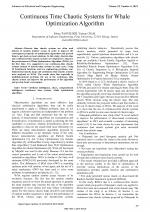| 4/2018 - 6 |
Continuous Time Chaotic Systems for Whale Optimization AlgorithmTANYILDIZI, E. |
| Extra paper information in |
| Click to see author's profile in |
| Download PDF |
Author keywords
artificial intelligence, chaos, computational intelligence, continuous time systems, whale optimization algorithm
References keywords
optimization(23), algorithm(12), chaos(11), chaotic(9), algorithms(9), systems(6), evolutionary(6), swarm(5), computation(5), applied(5)
Blue keywords are present in both the references section and the paper title.
About this article
Date of Publication: 2018-11-30
Volume 18, Issue 4, Year 2018, On page(s): 49 - 56
ISSN: 1582-7445, e-ISSN: 1844-7600
Digital Object Identifier: 10.4316/AECE.2018.04006
Web of Science Accession Number: 000451843400006
SCOPUS ID: 85058817066
Abstract
Discrete time chaotic systems are often used instead of random number arrays in order to improve the convergence properties of optimization algorithms and prevent them to get stuck on local solutions. In this study, discrete-time and continuous-time chaotic systems are employed to improve the performance of Whale Optimization Algorithm (WOA), for the first time. It is suggested to use continuous-time chaotic systems instead of discrete-time systems in some cases. Using 23 benchmark functions and two engineering problems, one-dimensional chaotic maps and continuous time chaotic systems were analyzed on WOA. The results show that especially in multidimensional problems the use of the continuous time chaotic system can improve the performance of the algorithm and provide faster convergence. |
| References | | | Cited By |
Web of Science® Times Cited: 2 [View]
View record in Web of Science® [View]
View Related Records® [View]
Updated 2 weeks, 4 days ago
SCOPUS® Times Cited: 2
View record in SCOPUS® [Free preview]
View citations in SCOPUS® [Free preview]
[1] An urban short-term traffic flow prediction model based on wavelet neural network with improved whale optimization algorithm, Du, Wangdi, Zhang, Qingyong, Chen, Yuepeng, Ye, Ziliu, Sustainable Cities and Society, ISSN 2210-6707, Issue , 2021.
Digital Object Identifier: 10.1016/j.scs.2021.102858 [CrossRef]
[2] Embedded chaotic whale survival algorithm for filter–wrapper feature selection, Guha, Ritam, Ghosh, Manosij, Mutsuddi, Shyok, Sarkar, Ram, Mirjalili, Seyedali, Soft Computing, ISSN 1432-7643, Issue 17, Volume 24, 2020.
Digital Object Identifier: 10.1007/s00500-020-05183-1 [CrossRef]
Disclaimer: All information displayed above was retrieved by using remote connections to respective databases. For the best user experience, we update all data by using background processes, and use caches in order to reduce the load on the servers we retrieve the information from. As we have no control on the availability of the database servers and sometimes the Internet connectivity may be affected, we do not guarantee the information is correct or complete. For the most accurate data, please always consult the database sites directly. Some external links require authentication or an institutional subscription.
Web of Science® is a registered trademark of Clarivate Analytics, Scopus® is a registered trademark of Elsevier B.V., other product names, company names, brand names, trademarks and logos are the property of their respective owners.
Faculty of Electrical Engineering and Computer Science
Stefan cel Mare University of Suceava, Romania
All rights reserved: Advances in Electrical and Computer Engineering is a registered trademark of the Stefan cel Mare University of Suceava. No part of this publication may be reproduced, stored in a retrieval system, photocopied, recorded or archived, without the written permission from the Editor. When authors submit their papers for publication, they agree that the copyright for their article be transferred to the Faculty of Electrical Engineering and Computer Science, Stefan cel Mare University of Suceava, Romania, if and only if the articles are accepted for publication. The copyright covers the exclusive rights to reproduce and distribute the article, including reprints and translations.
Permission for other use: The copyright owner's consent does not extend to copying for general distribution, for promotion, for creating new works, or for resale. Specific written permission must be obtained from the Editor for such copying. Direct linking to files hosted on this website is strictly prohibited.
Disclaimer: Whilst every effort is made by the publishers and editorial board to see that no inaccurate or misleading data, opinions or statements appear in this journal, they wish to make it clear that all information and opinions formulated in the articles, as well as linguistic accuracy, are the sole responsibility of the author.



